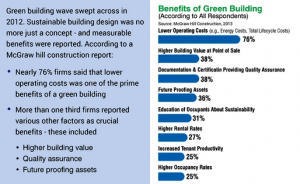According to a USGBC study, green building design is outpacing the growth of conventional construction sector in the US.
 Popularity of green building sector is rapidly increasing and it is set to create more the 2.3 million jobs for Americans, this year – reveals the 2015 Green Building Economic Impact Study report prepared by Booz Allen Hamilton.
Popularity of green building sector is rapidly increasing and it is set to create more the 2.3 million jobs for Americans, this year – reveals the 2015 Green Building Economic Impact Study report prepared by Booz Allen Hamilton.
Key findings of this study indicate that the contribution of green building industry is estimated to be more than $134.3 billion towards labor income for working Americans. Experts predict that by 2018, green building sector will create more than 3.3 million jobs, and will exceed one third of the total amount of jobs generated by the conventional construction industry in US. This will result in $190.3 billion towards labor earnings.
The study also dwelled into the economic contribution of sustainable buildings to the US economy and also quantified the economic impact of LEED certified green buildings. Today more than 2.3 million US workers are receiving $134 billion annually; this is because businesses, institutions and individual building owners are prioritizing sustainability for design, construction and operation of buildings. Consecutively this has also led to growing demand of green building programs such as LEED.
“Our research shows that green building has created millions of jobs and contributed hundreds of billions of dollars to the U.S. economy, with the construction of LEED-certified buildings accounting for about 40 percent of green construction’s overall contribution to GDP in 2015. This industry is certainly on the rise, and aggressive growth in the green building sector is anticipated over the next four years.” Said David Erne, a Senior Associate at Booz Allen.
 In addition to jobs, GDP and labor earnings, prioritization of green building design will also significantly influence tax contributions of individual states and environmental asset indicators at both national and state levels. It is estimated that construction projects for LEED buildings will generate total earnings that will reach around $8.4 billion till 2018. It is also anticipated that the green building sector will generate 1.26 million jobs from 2015 to 2018, in Texas.
In addition to jobs, GDP and labor earnings, prioritization of green building design will also significantly influence tax contributions of individual states and environmental asset indicators at both national and state levels. It is estimated that construction projects for LEED buildings will generate total earnings that will reach around $8.4 billion till 2018. It is also anticipated that the green building sector will generate 1.26 million jobs from 2015 to 2018, in Texas.
 Compared to conventional buildings, a green building with LEED standards, uses less energy and water, it makes optimized use of natural resources and generates lower utility bills. Green homes generate less waste, and cause minimum impact on the land it is built. Living in a green building is healthier and economical for its occupants. Naturally the demand and popularity of green design has increased. As the sector progresses it will also affect the growth green building materials. A BBC research report has indicated that green builting material market will reach $69 billion by 2019.
Compared to conventional buildings, a green building with LEED standards, uses less energy and water, it makes optimized use of natural resources and generates lower utility bills. Green homes generate less waste, and cause minimum impact on the land it is built. Living in a green building is healthier and economical for its occupants. Naturally the demand and popularity of green design has increased. As the sector progresses it will also affect the growth green building materials. A BBC research report has indicated that green builting material market will reach $69 billion by 2019.
 While the USGBC study mainly talks about the growth of green building design in US, the trend is also gaining pace in UK, Australia and Middle East and over 60 other countries.
While the USGBC study mainly talks about the growth of green building design in US, the trend is also gaining pace in UK, Australia and Middle East and over 60 other countries.
Earlier there were no clear drivers of green design, however the 2012 survey reported that client and market demand are the key drivers for green building design adoption. This demand has just kept on increasing and there is no looking back – today –
- Firms are finding business value and immense opportunities from green buildings – this not only includes economic benefits but also an opportunity to contribute towards environmentally responsible building design.
- Building owners and developers across the globe are prioritizing a sustainable approach towards building design. Becoming self-reliant for energy needs has become a popular trend as the NZEB wave has gripped the industry.
- Today home owners are also demanding for more than just plush interiors and impressive exteriors, they want lower utility bills without compromising on comfort and aesthetics.
Green building design plays a pivotal role in introducing energy efficiency in buildings and hence lower utility bills and has set a benchmark for design, construction and operation of buildings.
Source: Archinect

